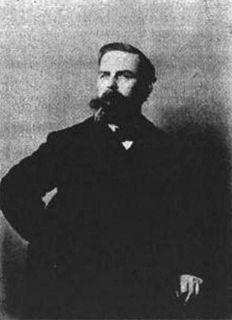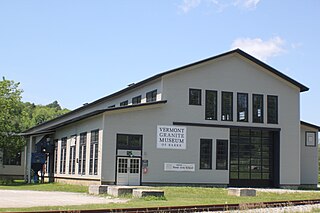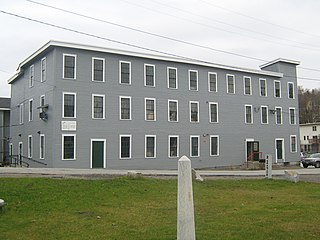
The Jonathan Bowers House is an historic house in Lowell, Massachusetts. Built in 1872 for a local businessman, it is one of the most unusual houses in Massachusetts, being a circular masonry building with Second Empire styling. It was listed on the National Register of Historic Places in 1976.

Lyon's Turning Mill is a historic turning mill that created granite columns on Ricciuti Drive in Quincy, Massachusetts.

The Italian Baptist Church is a historic church at 10 North Brook Street in the city of Barre, Vermont. Built in 1906-08 largely with volunteer labor, it is a distinctive regionalized example of vernacular church architecture more typically found in northern Italy. It was listed on the National Register of Historic Places in 1975.

The Barre Downtown Historic District encompasses the historic commercial and civic heart of the city of Barre, Vermont. Extending along Main Street from City Park to Depot Square, this area was developed quite rapidly in the 1880s and 1890s, when the area experienced rapid growth due to the expansion of the nearby granite quarries. It was listed on the National Register of Historic Places in 1979.

Lambert Packard (1832-1906) was an American architect from St. Johnsbury, Vermont.

The Bethel Village Historic District encompasses the historic core of the village of Bethel in the town of Bethel, Vermont, USA. The L-shaped district extends along Main and Church Streets, including many of the village's commercial and civic buildings, as well as a significant number of 19th and early 20th-century residences. The district was listed on the National Register of Historic Places in 1976, and was slightly enlarged in 1990.

The Beck and Beck Granite Shed is a historic granite shed at 34 Granite Street in the city of Barre, Vermont. Built in 1933, it is a rare surviving example of a rectangular granite shed, a late style of granite processing facility. The Beck and Beck Company was started by the area's first German immigrants, and operated until 1960. The building now houses a non-profit and store that repurposes and recycles building materials. It was listed on the National Register of Historic Places in 2011.

The Currier Park Historic District encompasses a historic late 19th-century affluent residential area of the city of Barre, Vermont. Centered around Currier Park, a rectangular park laid out in 1883 just east of the city's downtown, are a collection of a high quality predominantly Italianate and Queen Anne Victorian residences. The district was listed on the National Register of Historic Places in 1990.

The Vermont Granite Museum is a museum in the city of Barre, Vermont, devoted to the city's historically important granite quarrying and processing industry. It is located at 7 Jones Brothers Way, in the former Jones Brothers Granite Shed, a former granite processing facility listed on the National Register of Historic Places. The Stone Arts School, administered by the museum, is a teaching institution for aspiring sculptors.

The National Clothespin Factory is a historic industrial building at One Granite Street in Montpelier, Vermont. Built in 1918, it is a significant local example of an early 20th-century wood-frame factory, and was home to the nation's last manufacturer of wooden clothespins. Now adapted for other uses, the building was listed on the National Register of Historic Places in 2005.

The Scampini Block is a historic commercial building at 289 North Main Street in the city of Barre, Vermont. Built in 1904, it is an elegant showcase of the skills of local granite carvers, and was for many years a social center for the area's large immigrant stoneworkers. It was listed on the National Register of Historic Places in 2007.

The Joshua Twing Gristmill is a historic industrial facility at 450 North Main Street in the city of Barre, Vermont. Built in 1844, it is a remarkably high-style example of Greek Revival architecture for an essentially utilitarian industrial structure. Joshua Twing, its builder, was engaged for many years in a variety of industrial pursuits, primarily considered with engineering improvements in water wheels and turbines. The building was listed on the National Register of Historic Places in 1978.

The Union Co-operative Store Bakery is a historic commercial building at 46 1/2 Granite Street in the city of Barre, Vermont, USA.

143 Highland Avenue is a well-preserved late 19th-century tenement house in the town of Hardwick, Vermont. It was built about 1889 to serve as housing for workers in the area's granite quarries, and preserves a number of the utilitarian features that characterize these types of worker housing. It was listed on the National Register of Historic Places in 2000.

The Downtown Hardwick Village Historic District encompasses a significant portion of the downtown area of Hardwick, Vermont. The town developed in the 19th century first as a small industrial center, and later became one of the world's leading processors of granite. The district was listed on the National Register of Historic Places in 1982.
Clinton Smith was an American architect. He designed many buildings in Middlebury and around Vermont.

The Reynolds House, currently the Reynolds House Inn, is a historic house at 102 South Main Street in the city of Barre, Vermont. Built in the 1890s, it is a well-preserved high-style example of Late Victorian architecture, exhibiting both Queen Anne and Second Empire features. Built for a local merchant, it is a rare survivor of what was once a series of high-profile residences south of downtown Barre. It was listed on the National Register of Historic Places in 2020.
Granite Building may refer to:

The Hardwick and Woodbury Railroad was a short-line railroad serving the towns of Hardwick and Woodbury, Vermont. Built to serve the local granite industry by bringing rough stone from the quarries to the cutting-houses, the railroad was about 7 miles (11 km) long, plus leased track, extended to about 11 miles (18 km) at its greatest extent. It connected with only one other railroad, the St. Johnsbury & Lake Champlain, in Hardwick.

The Woodbury Granite Company (WGC) was a producer of rough and finished granite products. Incorporated in 1887, purchased and significantly reorganized in 1896, and expanded by merger in 1902 and thereafter, the company operated quarries principally in Woodbury, Vermont, but its headquarters and stone-finishing facilities were located in nearby Hardwick. Beginning as a quarrier and seller of rough stone, the company expanded into the business of finishing cut stone and grew from there. It made its name as a supplier of architectural (structural) granite, and grew to become the United States' largest producer, supplying the stone for many notable buildings, including several state capitols, numerous post offices, and many office buildings.





















